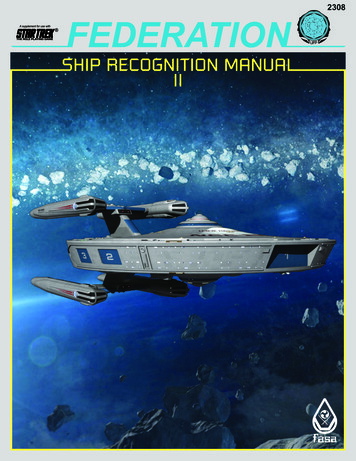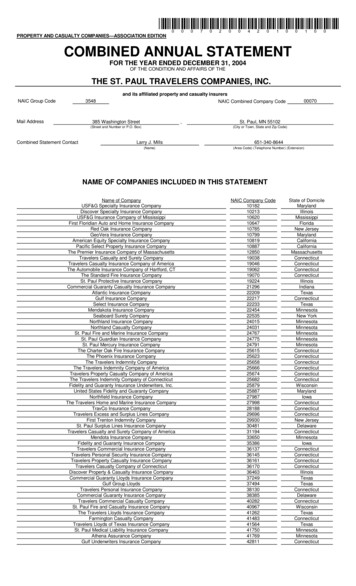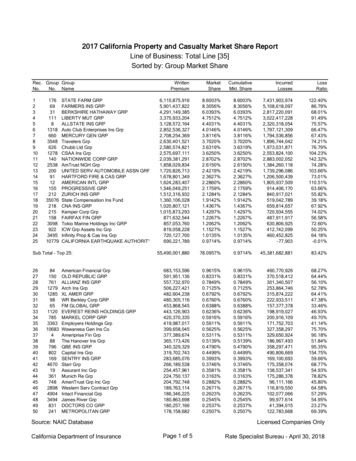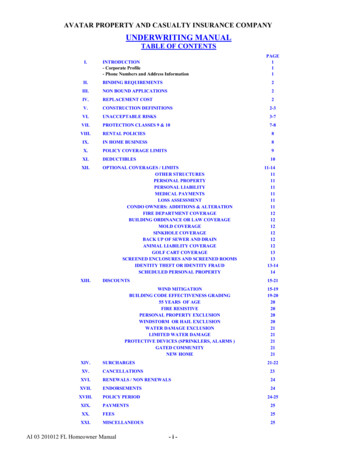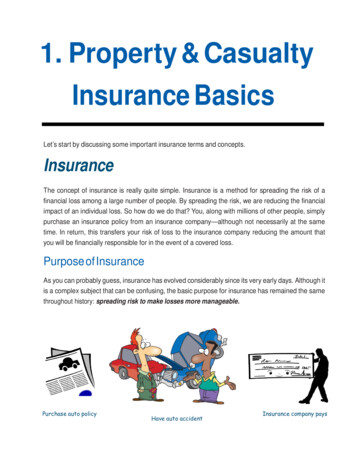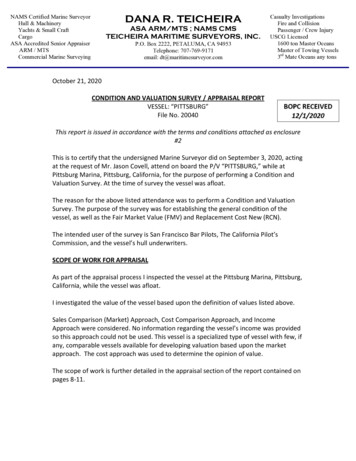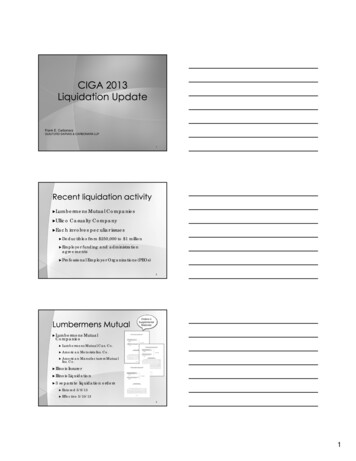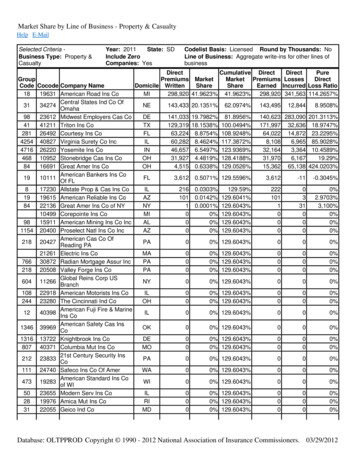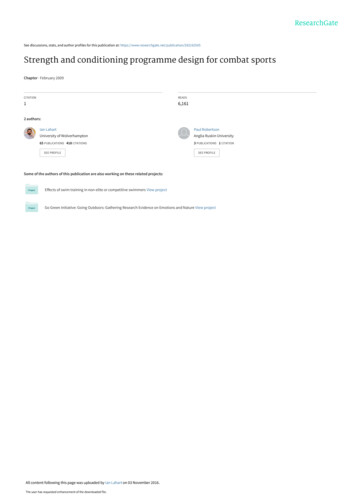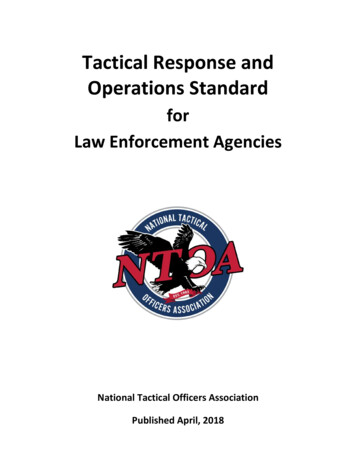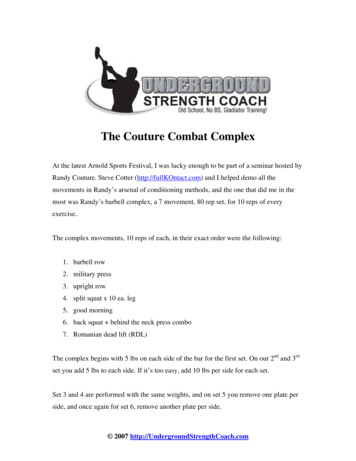
Transcription
U.S. ARMY MEDICAL DEPARTMENT CENTER AND SCHOOLFORT SAM HOUSTON, TEXAS 78234-6100TACTICAL COMBATCASUALTY CARE ANDWOUND TREATMENTSUBCOURSE MD0554EDITION 200
DEVELOPMENTThis subcourse is approved for resident and correspondence course instruction. Itreflects the current thought of the Academy of Health Sciences and conforms to printedDepartment of the Army doctrine as closely as currently possible. Development andprogress render such doctrine continuously subject to change.ADMINISTRATIONStudents who desire credit hours for this correspondence subcourse must enroll in thesubcourse. Application for enrollment should be made at the Internet website:http://www.atrrs.army.mil. You can access the course catalog in the upper right corner.Enter School Code 555 for medical correspondence courses. Copy down the coursenumber and title. To apply for enrollment, return to the main ATRRS screen and scrolldown the right side for ATRRS Channels. Click on SELF DEVELOPMENT to open theapplication; then follow the on-screen instructions.For comments or questions regarding enrollment, student records, or examinationshipments, contact the Nonresident Instruction Branch at DSN 471-5877, commercial(210) 221-5877, toll-free 1-800-344-2380; fax: 210-221-4012 or DSN 471-4012, e-mailaccp@amedd.army.mil, or write to:NONRESIDENT INSTRUCTION BRANCHAMEDDC&SATTN: MCCS-HSN2105 11TH STREET SUITE 4191FORT SAM HOUSTON TX 78234-5064Be sure your social security number is on all correspondence sent to the Academy ofHealth Sciences.CLARIFICATION OF TERMINOLOGYWhen used in this publication, words such as "he," "him," "his," and "men" 'are intendedto include both the masculine and feminine genders, unless specifically stated otherwiseor when obvious in context.USE OF PROPRIETARY NAMESThe initial letters of the names of some products may be capitalized in this subcourse.Such names are proprietary names, that is, brand names or trademarks. Proprietarynames have been used in this subcourse only to make it a more effective learning aid.The use of any name, proprietary or otherwise, should not be interpreted asendorsement, deprecation, or criticism of a product; nor should such use be consideredto interpret the validity of proprietary rights in a name, whether it is registered or not.
TABLE OF CONTENTSLessonParagraphsINTRODUCTION1TACTICAL COMBAT CASUALTY CARE1-1 -- 1-5Exercises2CONTROLLING BLEEDING FROM AN EXTREMITYSection I.Section II.Section III.Section IV.Section V.GeneralControlling External Bleeding From a Woundon an ExtremityApplying an Improvised TourniquetControlling Bleeding From an AmputationTreating Internal Bleeding in an Extremity2-1 -- 2-52-6 -- 2-212-22 -- 2-272-28 -- 2-312-32 -- 2-35Exercises3TREATING CHEST INJURIES.Section I.Section II.Section III.GeneralTreating Open Chest WoundsTreating Closed Chest Injuries3-1 -- 3-33-4 -- 3-133-14 -- 3-25Exercises4TREATING ABDOMINAL INJURIESSection I.Section II.Section III.GeneralTreating Open Abdominal WoundsTreating an Acute Abdomen4-1 -- 4-24-3 -- 4-114-12-- 4-14Exercises5TREATING HEAD INJURIESSection I.Section II.Section III.Open and Closed Head InjuriesTreating Open Head WoundsTreating Other InjuriesExercisesMD0554i5-1 -- 5-45-5 -- 5-105-11-- 5-15
Lesson6ParagraphsTREATING BURNSSection I.Section II.Section III.Section IV.Section V.GeneralTreating Thermal BurnsTreating Electrical BurnsTreating Chemical BurnsTreating Radiant Energy Burns6-1 -- 6-36-4 -- 6-136-14-- 6-206-21-- 6-256-26-- 6-28Exercises7TREATING HYPOVOLEMIC SHOCK7-1 -- 7-8Exercises8TREATING SOFT TISSUE INJURIESExercisesMD0554ii8-1 -- 8-6
CORRESPONDENCE COURSE OFTHE U.S. ARMY MEDICAL DEPARTMENT CENTER AND SCHOOLSUBCOURSE MD0554TACTICAL COMBAT CASUALTY CARE AND WOUND TREATMENTINTRODUCTIONWhen you have casualties on the battlefield, you must determine the sequence inwhich the casualties are to be treated and how to treat their injuries. This subcoursediscusses the procedures for performing tactical combat casualty care; treating injuries tothe extremities, chest, abdominal, and head; and controlling shock.Subcourse Components:This subcourse consists of eight lessons. The lessons are:Lesson 1, Tactical Combat Casualty Care.Lesson 2, Controlling Bleeding From an Extremity.Lesson 3, Treating Chest Injuries.Lesson 4, Treating Abdominal Injuries.Lesson 5, Treating Head Injuries.Lesson 6, Treating Burns.Lesson 7, Treating Hypovolemic Shock.Lesson 8, Treating Soft Tissue Injuries.Here are some suggestions that may be helpful to you in completing thissubcourse:--Read and study each lesson carefully.--Complete the subcourse lesson by lesson. After completing each lesson, workthe exercises at the end of the lesson, marking your answers in this booklet.--After completing each set of lesson exercises, compare your answers with thoseon the solution sheet that follows the exercises. If you have answered an exerciseincorrectly, check the reference cited after the answer on the solution sheet todetermine why your response was not the correct one.MD0554iii
Credit Awarded:Upon successful completion of the examination for this subcourse, you will beawarded 16 credit hours.To receive credit hours, you must be officially enrolled and complete anexamination furnished by the Nonresident Instruction Section at Fort Sam Houston,Texas.You can enroll by going to the web site http://atrrs.army.mil and enrolling under"Self Development" (School Code 555).A listing of correspondence courses and subcourses available through theNonresident Instruction Section is found in Chapter 4 of DA Pamphlet 350-59, ArmyCorrespondence Course Program Catalog. The DA PAM is available at the followingwebsite: 554iv
LESSON ASSIGNMENTLESSON 1Tactical Combat Casualty Care.TEXT ASSIGNMENTParagraphs 1-1 through 1-5.LESSON OBJECTIVESWhen you have completed this lesson, youshould be able to:1-1. Identify factors that influence combat casualtycare.1-2. Identify the stages of care1-3. Identify the procedures for care under fire.1-4. Identify the procedures for tactical field care.1-5. Identify the procedures for casualty evacuationcare.SUGGESTIONMD0554Work the lesson exercises at the end of this lessonbefore beginning the next lesson. These exerciseswill help you accomplish the lesson objectives.1-1
LESSON 1TACTICAL COMBAT CASUALTY CARE1-1.GENERALAs a combat medic on today’s battlefield, you will experience a wide variety ofconditions not previously experienced. Your training has prepared you on standardsthat apply to the civilian emergency medical service (EMS) world that may not apply tothe combat environment. These tools are a good basis for sound medical judgment;on today’s battlefield, this judgment could save the lives of your fellow soldiers. TheUS Army found the need to migrate away from the civilian standards and allow thecombat medics to analyze situations in ways not previously thought of. Thesetechniques are called "tactical combat casualty care" (TC3). These techniques andfactors will be discussed in the following paragraphs. Factors influencing combatcasualty care include the following.a. Enemy Fire. It may prevent the treatment of casualties and may put you atrisk in providing care under enemy fire.b. Medical Equipment Limitations. You only have what you carried in withyou in your medical aid bag.c. A Widely Variable Evacuation Time. In the civilian community, evacuationcan be under 25 minutes; but in combat, evacuation may be delayed for several hours.d. Tactical Considerations. Sometimes the mission will take precedenceover medical care.e. Casualty Transportation. Transportation for evacuation may or may notbe available. Air superiority must be achieved before any air evacuation assets will bedeployed. Additionally, the tactical situation will dictate when or if casualty evacuationcan occur. In addition, environmental factors may prevent evacuation assets fromreaching your casualty.1-2.STAGES OF CAREIn making the transition from civilian emergency care to the tactical setting, it isuseful in considering the management of casualties that occurs in a combat mission asbeing divided into three distinct phases.a. Care Under Fire. Care under fire is the care rendered by the soldier medicat the scene of the injury while he and the casualty are still under effective hostile fire.Available medical equipment is limited to that carried by the individual soldier or thesoldier medic in his medical aid bag.MD05541-2
b. Tactical Field Care. Tactical field care is the care rendered by the soldiermedic once he and the casualty are no longer under effective hostile fire. It also appliesto situations in which an injury has occurred, but there is no hostile fire. Availablemedical equipment is still limited to that being carried into the field by medicalpersonnel. The time needed to evacuate the casualty to a medical treatment facility(MTF) may vary considerably.c. Combat Casualty Evacuation Care. Combat casualty evacuation(CASEVAC) care is the care rendered once the casualty has been picked up by anaircraft, vehicle, or boat. Additional medical personnel and equipment may have beenpre-staged and are available at this stage of casualty management.1-3.CARE UNDER FIREa. Medical personnel's firepower may be essential in obtaining tactical firesuperiority. Attention to suppression of hostile fire may minimize the risk of injury topersonnel and minimize additional injury to previously injured soldiers. The bestoffense on the battlefield is tactical fire superiority. There is little time available toprovide care while under enemy fire and it may be more important to suppress enemyfire than stopping to care for casualties. The tactical situation will dictate when andhow much care you can provide. Finally, when a medical evacuation (MEDEVAC) isrequested, the tactical situation may not safely allow the air asset to respond.b. Personnel may need to assist in returning fire instead of stopping to care forcasualties. This may include wounded soldiers that are still able to fight.c. Wounded soldiers who are unable to fight and who are exposed to enemy fireshould move as quickly as possible to any nearby cover. If no cover is available or thewounded soldier cannot move to cover, he should lie flat and motionless (play dead).d. Figure 1-1 depicts a tragic situation. A wounded Marine is down in the street.A colleague attempts to come to his rescue along with a second Marine. Enemy firecontinues in the area and the first rescuer is critically wounded. The second rescuerreturns behind cover. Eventually, after enemy fire is contained, the first woundedMarine is rescued and the initial rescuer is permanently disabled. The point is, whenunder enemy fire, we cannot afford to rush blindly into a danger area to rescue a fallencomrade. If we do, there may be additional soldiers wounded or killed attempting torescue our wounded.MD05541-3
Figure 1-1. Soldier and rescuers wounded.e. Medical personnel are limited and, if they are injured, no other medicalpersonnel will be available until the time of evacuation during the CASEVAC phase.f. No immediate management of the airway is necessary at this time due to thelimited time available while under enemy fire and during the movement of the casualtyto cover. Airway problems typically play a minimal role in combat casualties. Woundingdata from Viet Nam indicates airway problems were present in only about one percentof combat casualties, mostly from maxillofacial injuries.g. The control of hemorrhage (major bleeding) is important since injury to amajor vessel can result in hypovolemic shock in a short time frame. Extremityhemorrhage is the leading cause of preventable combat death.NOTE:Over 2,500 deaths occurred in Viet Nam secondary to hemorrhage fromextremity wounds; these casualties had no other injuries.h. The use of temporary tourniquets to stop the bleeding is essential in thesetypes of casualties. If the casualty needs to be moved, as is usually the case, atourniquet is the most reasonable initial choice to stop major bleeding. Ischemicdamage to the limb is rare if the tourniquet is left in place for less than one hour(tourniquets are often left in place for several hours during surgical procedures). Inaddition, the use of a temporary tourniquet may allow the injured soldier to continue tofight. Both the casualty and the soldier medic are in grave danger while applying thetourniquet and non-life-threatening bleeding should be ignored until the tactical fieldcare phase.MD05541-4
i. The need for immediate access to a tourniquet in such situations makes itclear that all soldiers on combat missions have a suitable tourniquet, such as theCombat Application Tourniquet (CAT) shown in figure 1-2, readily available at astandard location on their battle gear and that soldiers be trained in its use.Figure 1-2. The Combat Application Tourniquet (CAT).j. Penetrating neck injuries do not require cervical spine (C-spine)immobilization. Other neck injuries, such as falls over 15 feet, fast roping injuries, ormotor vehicle collisions (MVC), may require C-spine immobilization unless the danger ofhostile fire constitutes a greater threat in the judgment of the soldier medic. Studieshave shown that, with penetrating neck injuries being only 1.4 percent of the injured,few would have benefited from C-spine immobilization. Adjustable rigid cervical colors(C-collars) should be carried in the soldier medic's medical aid bag. If rigid C-collars arenot available, a SAM splint from the aid bag can be used as a field expedient C-collar.k. Litters may not be available for movement of casualties.(1) Consider alternate methods to move casualties, such as ponchos, poleless litters, SKEDCO or Talon II litters, discarded doors, dragging, or manual carries).(2) Smoke, CS (2-chlorobenzalmalononitrile, a type of riot control gas), andvehicles may act as screens to assist in casualty movement.l. Do not attempt to salvage a casualty's rucksack
US Army found the need to migrate away from the civilian standards and allow the combat medics to analyze situations in ways not previously thought of. These techniques are called "tactical combat casualty care" (TC3). These techniques and factors will be discussed in the following paragraphs. Factors influencing combat casualty care include the following. a. Enemy Fire. It may prevent the .
